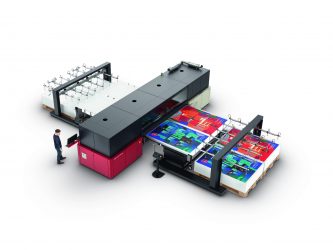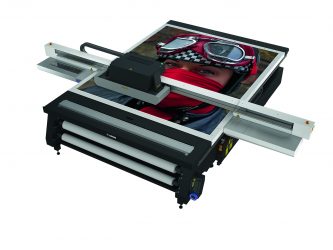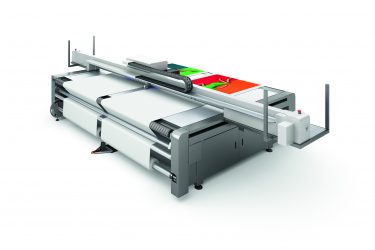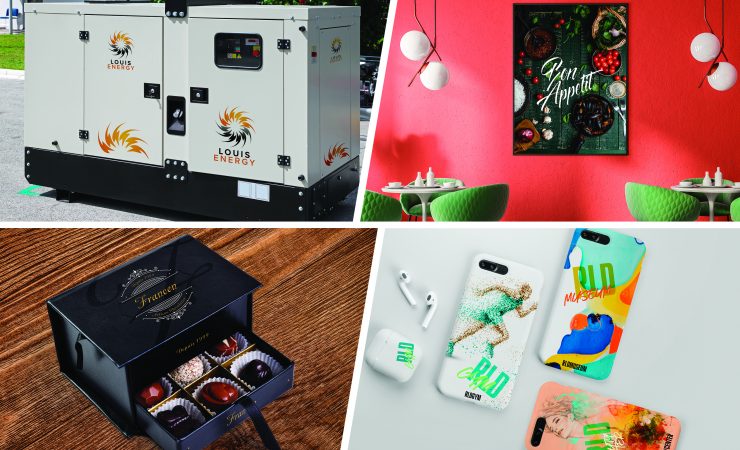Flatbed wide-format printers have been around for 20 years, while hybrids are a much more recent arrival. Can one printer do it all or is it still horses for courses? Michael Walker looks at the options
ne of the great strengths of inkjet technology is the ability to print onto just about anything. But that does require a printer designed to be able to handle that anything and able to pass the printheads over it at a suitable distance for the printing to happen, followed by whatever curing or drying process might be necessary to produce print ready for finishing or installation.
As long as you’re happy printing to flexible materials that come on rolls, that’s relatively straightforward to achieve. But when the media is rigid, thick or heavy – sometimes it’s all three – you need something different. In analogue print, that’s where screen printing comes in, and in digital it used to mean you had to have a flatbed.
In recent years, though, there’s been quite a trend towards ‘hybrid’ printers. These are usually roll-fed machines to which loading and unloading tables can be added to support rigid media, which is then advanced under the printhead gantry in the same way as the roll substrate, and usually at the same speed. It can also mean flatbed devices, though, to which feed and take-up rollers have been added so that flexible media can be drawn across the bed, printed, and then advanced and rewound after drying or curing. There’s often a performance hit compared to flatbed performance here.
UV ubiquity
The vast majority of flatbed devices use UVcurable ink as that suits the wide range of substrates they typically have to print to, from display board materials like Foamex or Dibond, to wood, glass, stone (natural or composite) or metals. UV inks offer good adhesion, though a primer may be needed with some metals and with glass, and form a tough layer of ink which generally has good durability for long-lived and outdoor applications. The downside is that UV-cured inks are often not considered safe in health-sensitive environments such as schools or hospitals, though an increasing number carry Greenguard certification.
The only real exception is latex, championed by HP, which being water-based allows use in more sensitive settings and because of its very thin dried layer, doesn’t obscure grain or texture in the substrate in the way that a cured UV ink layer does. Water-based inks do require more energy to dry than LED-cured UV ones, though, and in terms of overall productivity, current offerings can’t compete at the top end. Mutoh also offers a resin ink which has similar texturepreserving benefits to latex and lower energy demands.
The UV-cured cohort has more or less moved completely away from the older mercury vapour lamps towards LEDs for curing, which are dramatically cheaper to run and don’t tend to need replacing during the lifetime of the machine either. Some UV printers also allow you to play with the curing process settings in order to achieve different visual finishes.
Productivity parameters
Automation is also something that needs to be considered if high productivity matters. In wide-format, that’s probably more about managing lots of different jobs in a shift than outputting large numbers of the same – though that can happen too, if you’re serving a national retail chain or franchise, for example. The larger flatbeds usually allow for splitting the bed into zones, enabling fresh media to be loaded while the previous sheet is being printed, and the higher-speed offerings such as those from Agfa, Durst or Inca, include robotic load/unload options too. Machines at this end of the scale are also able to compete with screen printing for speed, with all the benefits of digital print for instant and free set-up, though of course they can’t do the unlimited special colours or always hit the density and consistency for flat colour areas without going to the slower higher quality modes.
On the roll-fed side, automation usually means the ability to handle longer and therefore heavier and fatter rolls, typically to allow unattended overnight operation, and on the wider machines (typically 3m and up) the ability to run multiple narrower rolls in parallel, allowing different jobs on different media to be imaged simultaneously. Roll-feed add-ons for flatbeds don’t usually tend to support either of these options.
An argument that’s generally been in favour of flatbeds is accuracy, as holding the media steady and moving the printhead over it generally gives better positional placement and front-to-back registration (though Inca actually moves the whole bed in and out under the printhead rail). Roll-fed output has to be cut and then mounted, so there’s some latitude for correction at that stage, but if you’re printing onto a door or oddshaped piece of metal, or double-sided onto glass or acrylic, you’ve only got one shot at getting everything in the right place. Printing direct to the substrate also avoids the two stage print-then-laminate process that users of roll-fed machines typically have to go through to produce display boards or other rigid products.

Agfa’s top-of-the-line Jeti Tauro H3300 hybrid supports full automation for maximum throughput
Agfa’s hybrid offering includes UV LED models in both the entry-level Anapurna range, which UK sales manager Bobby Grauf says has been the UK’s ‘favourite hybrid system’ four years running, and the high-end Jeti Tauro line. Debuted in 2018, the 3.3m Tauro family gained new members in October 2020 with the launch of a reduced printhead count but field upgradeable version, the H3300 S, plus an interior décor focused variant, the InterioJet, which uses water-based inks. There is a wide range of automation options for the Tauro models, which Mr Grauf says were particularly useful for users switching between roll and flatbed production in response to pandemic demands, and further software developments are promised for 2021.
The most recent addition to the Canon flatbed range is the Arizona 2300. Launched in September 2020, there are six models in the range, the 1.25 x 2.5m 2340/60/80 GTF, and the 2.5 x 3.08m 2340/60/80 XTF lines. Productivity and sustainability are key themes: Canon’s Derek Joys says that over 60% of large format jobs are required within 24 hours. Canon claims a 40% energy reduction compared to other flatbeds via ‘instant on’ operation and low ink consumption across the 2300 range, with productivity up to 95sqm/ hr, aided by Flow vacuum technology that makes secure substrate positioning simpler and quicker. Pneumatic registration pins allow alignment to the right, left or both sides of the bed, and 2/4/6-up printing is possible. Textured effects are supported via Touchstone software and there’s also a roll media option for materials up to 2.2m wide. Robotic loading/unloading options can be provided for full automation.
Durst launched the latest addition to its P5 line of UV hybrids in late 2020, a high speed version of its 3.5m P5 350, equipped with eight printheads with LED curing and capable of up to 650sqm/hr. The company is focusing on the complete ‘pixel to output’ process, placing equal emphasis on the inks, automation, software and services surrounding its machines to provide ‘versatility, sustainability and functionality’. This includes Automat, automation that supports mixed-size board loading and output stacking, plus a retracting registration table that allows rapid single operator switching between rigid and roll media. Software includes Smart Shop e-commerce, workflow and analytics and the ability to drive non-Durst printers via a new agreement with PrintFactory.
Durst UK managing director Peter Bray told Digital Printer, ‘Some of the demands and challenges we are seeing from the large format print sector cover JIT orders and deliveries, short-run orders, 24×7 service and the ability to work from everywhere.’
For higher throughput, the Vutek line are all hybrids. The LX3 Pro is a 3.2m LED machine fit for 215sqm/ hr (in ‘production’ mode), while the 3.2m HS125 comes in two flavours, capable of 125 8 x 4 ‘boards’ per hour (production, 90/hr in PoP quality), or the F4 variant that doubles CMYK printheads at the expense of other colours such as white and (almost) doubles performance for 225 boards/hr. There’s also the Vutek 32h, also 3.2m, offering up to 60 boards/hr. It and the LX3 use LEDs for curing; the HS125 doesn’t. The most recent Vuteks are the h3/h5, 3- and 5m hybrids launched in 2018. They offer 1200dpi resolutions, LED curing and a number of productivity and quality enhancements for 73 (h3) or 109 (h5) boards per hour.
Fujifilm has had a long-standing relationship with Canon Océ (as was), rebadging the Arizona line of flatbeds and integrating with its own RIP and workflow offerings. This arrangement included the Arizona 1300 line introduced in 2019, which is still offered as the Acuity LED 40, offering 1.25 x 2.5m and 2.5 x 3.1m beds. Fujifilm makes the ink for both vendors, and it has Greenguard Gold certification. It’s not clear at the time of writing whether the newer Canon Arizona 2300 line launched in 2020 (see above) is also included in this OEM agreement.

Canon’s most recent addition is the Arizona 2300, available in two sizes, and claimed to be 40% less demanding of energy
The only exception to the parade of UV printers is the latex hybrid models from HP, which brought its water-based ink technology to rigid media in 2018 with the R2000, a 2.5m width printer, complemented by the arrival of the 1.6m R1000 a few months later. Both are intended to ‘bring vibrant colours into the rigid printing world,’ according to HP, and include a white ink that ‘doesn’t yellow over time like traditional UV-based white ink.’
The current portfolio includes the Latex R2000 Plus and Latex R1000 Plus, both of which offer roll-or belt-driven sheet-feeding with 5- and 3l capacity ink cartridges respectively, both including white. The entry-level Latex R1000 now offers the same format, inks and capacities as the ‘Plus’ variant but supports sheet-fed feeding only as standard, with roll-feeding via an optional accessory.
Cambridge-based Inca Digital specialises in high throughput flatbeds and gave a boost to its X2 and X3 machines with ‘HS’ versions in 2019. These are 3.2 x 1.6m models, respectively offering up to 835 and 1450sqm/ hr, achieved by a ‘single cycle’ double-pass mode, Fujifilm OX inks and supported by a 30-second setup time and improved table movement (Inca printers move the bed under the printhead gantry). An ‘HS’ version of the X1 is in beta testing using the same technologies, and will boost the speed from 450 to 600sqm/hr. It will also allow print quality (number of passes) to be varied within a job, according to what’s in it.
Automation is key to high volume flatbed printing and Inca has demonstrated robot loading and unloading, as well as software optimisation including remote job set-up and MIS integration. Other ways of addressing overall quality/ productivity trade-offs are also under active investigation according to Inca’s head of products and solutions Matt Brooks.
Inktec has a pair of UV LED-cured flatbeds in its range. The Jetrix LXi7 is a 2.5 x 3m model that prints at up to 78sqm/ hr with white, varnish and primer options available in addition to CMYK plus light C and M inks, complemented by a zonal vacuum system. It’s targeted towards entrants to direct-to-substrate printing, while the more powerful Jetrix LXi8, a 2 x 3.2m model, offers up to 206sqm/hr on material up to 100mm thick. The LXi8 is also available in 12-, 14- or 16-channel versions, the middle one allowing double white channels, popular with customers who need white, and the last double everything for maximum throughput; the colour gamut has been praised too. Both models are said to be competitively priced against alternatives.
Represented in the UK by Hybrid Services, the flatbed range from Mimaki ranges in size from the desktop A3 UJF-3042FX to the 5 x 10ft JFX500. Introduced in 2019, the JFX200-2513EX is the current incarnation of the Japanese manufacturer’s offering for the popular 1.3 x 2.5m (4 x 8ft board) size, offering significant speed gains over its predecessor, plus the ability to build up ‘2.5D’ textured effects.
Hybrid’s Martin Southworth comments, ‘We have had a great response from creative professionals to the technology but equally, signmakers and commercial printers have seen a value to it for producing important, textural detail in a wide variety of print applications.’ The LED curing JFX2002513EX retails at £67,995 and can print onto substrates up to 50mm thick.
Better known for its roll-fed offerings, Mutoh does have a true flatbed in its line-up, the 1.25 x 2.54m PerformanceJet 2508UF. Introduced at Fespa 2018, it handles substrates up to 100mm thick. There are two hybrids as well, the ValueJet 1627MH, launched later the same year, and the ValueJet 1638UH. Both are 1.6m roll printers with rigid media capability, a white ink option and support for media up to around 15mm thick, the latter with LED curing and a choice of inks for flexible or rigid applications, while the former uses Mutoh’s multipurpose resin ink. This is solvent-based but is said to work with a range of typical rigid display substrates. It needs less heat than latex to dry, allowing the use of more heat-sensitive materials, but can’t be laminated immediately after printing.
Ricoh is a relative newcomer to the flatbed sector, having introduced its Pro T7210, a 2 x 3m flatbed aimed at industrial and décor applications in 2018. It offers white and clear inks plus primer in addition to CMYK and produces 50sqm/hr in production quality. A smaller flatbed, the 2.5 x 1.3m Pro TF6250 was added in 2019, built on the same platform and offering a choice of ink sets optimised for signage or for industrial use. It gained hybrid capabilities with the addition of a 2.2m roll-feed last year and was redesignated as the TF6251, due to ship around now. Output is up to 116sqm/hr on rigid substrates and 67sqm/hr on roll media; a flatbed-only version is still available. All Ricoh wide-format printers are driven by ColorGate RIP software.
A range of new flatbed printers has just been introduced by Roland DG. The VersaUV LEC2-S series offers two widths and three standard lengths across four variants, from 762 x 1750mm up to 1625 x 3818mm, plus the option for bespoke lengths or belt-drive variants. They all use Roland’s new EUV5 ink which is said to cut printing costs and includes clear, white and primer as well as CMYK.

Some flatbeds have roll capability. The Nyala 3 from swissQprint is unusual in that it also supports dual-roll printing in that configuration
For ‘small but tall’ items, Roland also has the LEF2-300D, introduced in March 2020, a desktop LED printer suitable for personalising items as diverse as phone cases and shoes, printing on a wide range of materials. Roland Europe’s Paul Willems told Digital Printer, ‘Given the constantly changing nature of the print sector as a result of Covid-19, a major trend will continue to be a focus on using existing kit to full potential to maximise ROI. In the same breath, many companies have held back in making investments… and will be ready for a period of resurgence and growth as vaccinations are rolled out and lockdowns eased.’
Mr Willems also pointed to predicted growth in both personalisation and interior décor applications. There are three flatbed models in the swissQprint range, with two higher speed variants. The entry model is the Oryx 3, a 65sqm/hr 2.5 x 2m machine with up to nine printheads for CMYK plus any five other colours, including white and clear. The Impala 3 is the same format but supports up to 18 printheads and is capable of 180sqm/hr in its standard version, or 317sqm/hr in the ‘3S’ model, though colour choice is here restricted to CMYK plus one other.
The biggest format, at 3.2 x 2m, is offered in the Nyala 3, which produces 206sqm/hr in standard configuration and 370sqm/hr in the 3S variant, with the same choices/ restrictions on colours as the Impala. All models use LED UV-curing and feature the company’s new TipSwitch vacuum zone setting system.





